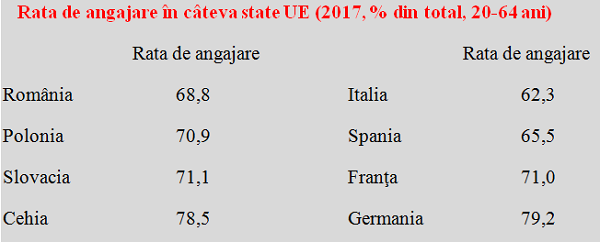 The employment rate of Romanian population aged between 20 and 64 years was 68.8% last year, according to data released by Eurostat.
The employment rate of Romanian population aged between 20 and 64 years was 68.8% last year, according to data released by Eurostat.
This figure was significantly below the EU average of 72.2% and the lowest in the region where the neighbours Bulgaria (71.3%) and Hungary (73.3%) framed the same average.
It is worth to note: we returned only in 2017 to the level of 2001, a year when we were still above the EU average, at least according to the revised official data then quite strongly downward.
If we were to look at the relative situation from the crisis years 2010-2011 and the year when we managed to return with the GDP to the value from 2008, the negative spread between us and the EU remained almost unchanged, somewhere around three percentage points and a half.
- Evolution of employment rate in Romania compared to the EU average
- (2001-2017, % of the total, between 20-64 years)
*
Employment rate
The employment rate measures the proportion of people between 20 and 64 years of age who are employed. The definition refers to all persons who, during a reference week, have worked at least one hour for a salary or profit or who have been temporarily absent from such an activity. The indicator measured this way should not be compared with the annual or quarterly unadjusted series, which may give slightly different results.
*
Beyond the development level of a country, the situation regarding the capacity to create stable jobs and employment stimulation policies, Eurostat data show a strong cultural trait that does not take into account the factors mentioned above. Instead, adjusted with the need to have the things that are necessary for life, it takes shape quite clearly depending on the relation to a certain deep-rooted social concept and the vicinity.
*
- Employment rate in some EU states (2017, % of total, 20-64 years)
- Employment rate Employment rate
- Romania Italy
- Poland Spain
- Slovakia France
- Czech Republic Germany
*
There are elements that should be considered in terms of measures taken by public decision makers, with an indication of the feasible models that would be useful to follow.
It is certain that we have an insufficiently used resource from the production factors point of view, at a time when all analyses of potential GDP (the one that can be reached without affecting the macroeconomic equilibrium) show that labour’s influence is decreasing more and more, even heading to zero in the medium term.
*
- Contribution of production factors to potential GDP
- Year Potential GDP Capital Labour Productivity (PTF)
*
Of course, it would be very good to rely on capital increases (0.2 percentage points on annual basis), to have as much investment as possible in infrastructure, machinery and equipment as best as possible, and to use modern production methods to increase productivity and added value. However, beyond a rather external and qualitative approach, the old internal and quantitative resource should not be neglected at all.
Bluntly put, we can see how Germany or the Czech Republic has no problem in increasing their economic output, to a considerable extent, by extensive methods. Methods by which they also manage to balance their public finances by transferring large masses of population from being simple beneficiaries of public services to having them paid by these people through taxes related to the work done.
That unless (and we should seriously meditate on that, even though it touches a sensitive issue from the political and social point of view), this is exactly what makes the difference between, let’s say, Germany and France, or, closer to our level, between the Czech Republic and Slovakia. Of course, if we admit that the other production factors would be at a similar level.
Beware, though, the simple improvement of this indicator, otherwise evident in recent years (not in the budget too, for reasons of questionable tax and revenue policy measures) is not enough, but needs to be seen in a wider European context. The context in which lagging behind, a situation to which we are already used, maintains and the convergence does not really happen.


 *
*








